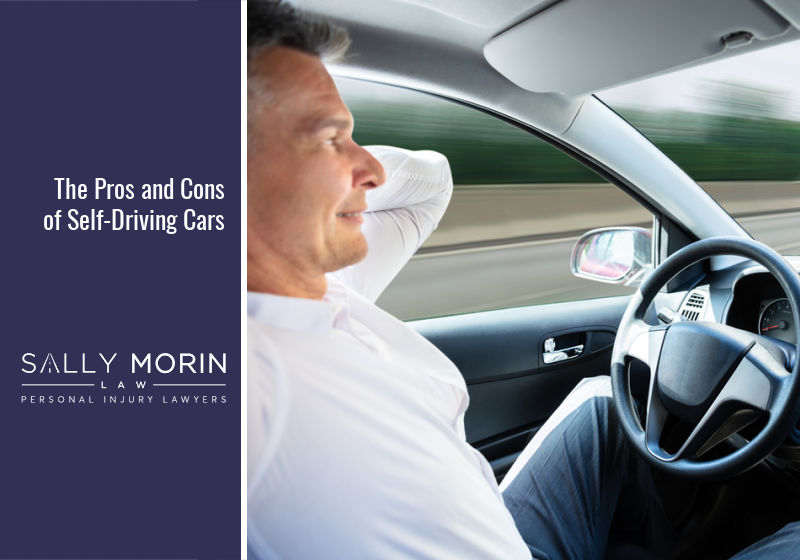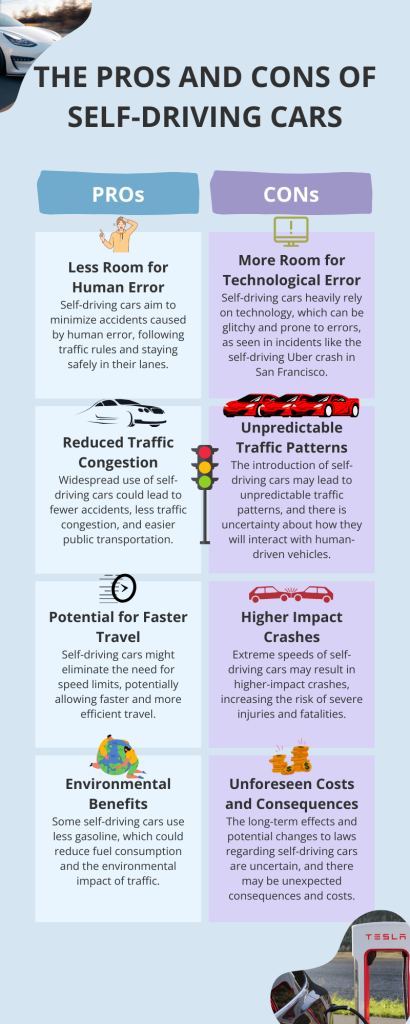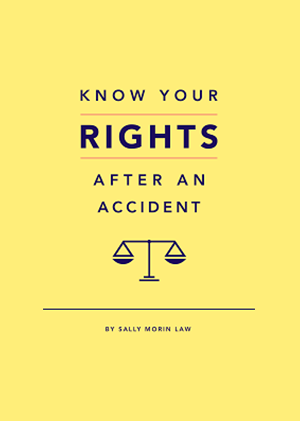Up to 94% of all traffic accidents are caused by human error according to the National Highway Traffic Safety Administration. So would removing human error make our roads safer?
This is the concept behind self-driving cars, the innovative vehicles that use technology to stay safe on the road. There are already about 30 million partially autonomous vehicles in the world and this number is expected to exceed 50 million within just a few years.
Truly “driverless” fully autonomous cars exist but they aren’t widespread on the roads – at least, not yet! Companies like Tesla, Waymo, and Uber seem determined to change that as soon as possible.
From a legal standpoint, self-driving cars create complex problems. Plus, driverless car accidents are on the rise. Here in California, some people are skeptical that they’re really making our roads safer.
At Sally Morin Personal Injury Lawyers, we’ve been watching the autonomous car trend unfold as California has become famous for its driverless car evolution. Here are some of the potential pros and cons:
Pro: Less Room for Human Error
Ideally, self-driving cars minimize the chance of a person making an error that leads to an accident. These vehicles are supposed to stay safely in their lane, follow traffic rules, and protect the people inside the vehicle as well as others on the road.
But reality doesn’t always match this perfect picture. Research shows self-driving features give people a false sense of safety that leads to unsafe driving behavior. For example, someone might assume a partially autonomous car drives on “autopilot” but actually, it still needs human guidance.
Con: More Room for Technological Error
Here’s an obvious but significant drawback about self-driving cars: They rely heavily on technology. So far, self-driving vehicle technology is a bit glitchy and prone to errors.
Look at the famous example of the San Francisco pedestrian killed in a self-driving Uber crash. Investigators determined the vehicle’s technology sensed that the pedestrian was there but failed to apply the brakes. The human driver was too distracted to react before the crash.
Pro: Reduced Traffic Congestion
One of the biggest promises of self-driving cars is the possibility of reducing congestion on our nation’s roads. If driverless cars were widespread, there could be fewer accidents, fewer traffic jams, and reduced demand for highway police and EMTs. Public transportation could become much easier too.
Potentially, this could lead to additional benefits like lower insurance costs, less gasoline usage, and a minimal chance of injuries and damages from car accidents. Traveling in traffic wouldn’t be such a hassle.
Con: Unpredictable Traffic Patterns
We have decades of research about how traffic patterns work with the millions of human drivers already on our roads, but there’s very little information available about self-driving vehicle traffic. How would the roads be different if they were dominated by driverless cars? The truth is, nobody knows.
We tend to view machines as reliable and predictable. However, studies have found that both human drivers and self-driving cars can exhibit unpredictable behavior. Humans drive differently when they’re in a rush and might run a red light out of impatience, for example.
But driverless cars aren’t perfect either, and sometimes get confused by things like construction, gravel roads, pedestrians, and animals in the roadway. The Insurance Institute for Highway Safety says self-driving cars “could struggle to eliminate most crashes.”
Pro: Potential for Faster Travel
Wouldn’t it be great if we could do away with speed limits and just trust self-driving cars to transport us at rocket speed? This is one of the potentially huge benefits of driverless vehicles.
You could get home from work in a flash. School buses wouldn’t slow everyone down on the road. Big rigs could deliver goods quickly and safely. Ambulances could get people to the hospital faster and save more lives.
Con: Higher Impact Crashes
Extreme speed brings extreme risk. Imagine that a self-driving car traveling at 100 mph crashes into another vehicle. This high-impact crash brings a high risk of death and severe injury.
One study found that for every 5 mph increase in speed, there were 8% more road fatalities. How self-driving cars will factor into these kinds of statistics remains to be seen.
Pro: Environmental Benefits
Here in California, we love keeping things green. Some self-driving cars use less gasoline so if more were on the roads, there could be fewer fuel-guzzling traffic jams to harm the environment.
Plus, there could be a lower risk of semi-truck accidents with chemical spills, explosions, and other environmentally damaging side effects. That’s good for the Earth and good for all of us.
Con: Unforeseen Costs and Consequences
Finally, a major drawback of self-driving cars is that we simply don’t know all of their potential effects yet. There’s a big difference between having a few driverless cars on the road and having a road dominated by autonomous vehicles.
How will the law continue to evolve regarding self-driving cars? Nobody knows! There could be unexpected changes to the law in terms of making personal injury claims and securing compensation if a self-driving car hits you.
As the future of autonomous vehicles becomes a reality, the team at Sally Morin Personal Injury Lawyers will be watching closely. You can trust us to stay ahead of the curve when it comes to understanding the impact of new traffic technology like self-driving cars!
Safety Features of Self-Driving Cars
Self-driving cars are a revolutionary advancement in car technology that come with a range of advanced safety features not found in traditional vehicles. These innovations are designed to make driving safer and reduce accidents, which is one of the main advantages and disadvantages of self-driving cars.
1. Collision Avoidance Systems
One of the key features of autonomous vehicles is their ability to avoid collisions. This technology uses sensors and cameras to detect potential collisions and automatically takes action to prevent them. Whether it’s applying the brakes or changing lanes, collision avoidance systems work tirelessly to keep both passengers and pedestrians safe.
2. Adaptive Cruise Control
Unlike regular cruise control systems that only maintain a set speed, adaptive cruise control (ACC) goes a step further by adjusting the speed based on traffic conditions. ACC can slow down or speed up as needed, while also keeping a safe distance from other vehicles without any input from the driver.
3. Lane Departure Warning Systems
Lane departure warning systems are designed to alert drivers when their vehicle starts drifting out of its lane without using the turn signal. In self-driving cars, these warnings can prompt corrective measures to gently steer the car back into the correct lane, reducing the risks associated with driver inattention or fatigue.
With their advanced sensors, cameras, and radar systems, self-driving cars have an unmatched ability to monitor their surroundings. This constant awareness enables them to:
- Detect objects and movements around the car with great accuracy
- Predict potential dangers faster than human reflexes
- Take proactive measures to prevent accidents
The incorporation of these technologies into self-driving cars holds great potential for improving road safety. By eliminating common mistakes made by human drivers such as distracted or impaired driving, autonomous vehicles could significantly decrease traffic accidents. As they continue to develop and get better, self-driving cars are leading the way in making our roads safer for everyone.
Societal Impacts of Self-Driving Cars
Self-driving cars are set to completely transform society, changing how we use transportation in profound ways. These autonomous vehicles will have a major impact on our everyday routines, city landscapes, and the larger social and economic structure.
1. Changes in Urban Planning and Infrastructure
Cities will need to undergo significant changes to accommodate the integration of self-driving cars smoothly. This transformation will involve:
- Adapting road layouts to optimize for autonomous traffic patterns.
- Implementing smart signals that can communicate with self-driving cars for more efficient flow.
- Reducing the need for parking spaces in densely populated areas as self-driving cars can park themselves in remote locations.
2. Increased Accessibility to Transportation
Self-driving cars bring the promise of a new era of mobility, providing:
- Unprecedented freedom for the elderly and disabled who have previously relied on others for transportation.
- Access to safe and reliable vehicles at all times, especially in areas that are currently underserved by traditional transportation options.
3. Potential Reduction in Traffic Congestion
There are several expected benefits when it comes to reducing traffic congestion:
- Self-driving cars can adjust their speeds and routes in real-time, leading to smarter management of traffic flow.
- With more people opting for ridesharing services and higher utilization rates of each vehicle, there may be a decreased need for a large number of cars on the roads.
4. Impact on Public Transportation Systems and Ridesharing Services
The effects on public transit and rideshare networks will be complex:
- Self-driving cars could either complement existing public transportation systems by serving as a solution for first-mile/last-mile connectivity or become a competing mode of travel.
- Ridesharing services might shift their focus from connecting drivers with passengers to managing fleets of autonomous vehicles.
By examining these societal implications, it is clear that self-driving cars are not just a technological advancement but also a driving force behind significant changes in various aspects of our daily lives. As we look forward to the transformation of our cityscapes and delve into the details of this transportation revolution, it becomes evident that the impact on society will be profound and widespread.
Regulatory Challenges Posed by Self-Driving Cars
As self-driving cars become more prevalent, they face significant regulatory challenges. The technology has advanced faster than the creation of laws and guidelines, creating a confusing legal environment for manufacturers.
Lack of Consistent Regulations
Regulations for self-driving cars are still in the early stages. Different regions have vastly different rules and standards, making it difficult for manufacturers to navigate. For example, some states in the U.S., like California and Arizona, actively support testing and use of autonomous vehicles, while others have strict regulations or bans in place.
This lack of consistency in regulations creates barriers for testing and deploying self-driving cars. Companies often have to adjust their plans to meet various requirements and limitations in different areas. A clear example is Uber’s initial autonomous vehicle program, which was stopped in San Francisco due to regulatory issues but continued in Arizona.
Need for Updated Laws
Dealing with these regulatory challenges requires new laws and guidelines specifically tailored to self-driving cars. One crucial aspect is determining who is responsible in case of accidents. Current laws hold the driver accountable, but with autonomous cars, it becomes complicated and could involve manufacturers or even software developers.
Another legal obstacle is ensuring data privacy and security. Since self-driving vehicles rely heavily on collecting data for navigation and decision-making, there are concerns about how this information is stored, used, and safeguarded.
Impact on Insurance
The rise of self-driving cars also has implications for insurance policies. If automation removes human error – a leading cause of accidents – it could lead to lower insurance costs. However, insurers need clear regulations on handling claims for accidents involving autonomous vehicles.
In summary, while self-driving cars offer exciting improvements in safety and efficiency, they also bring unique legal challenges that require immediate attention from policymakers worldwide. As we move towards a future where autonomous vehicles are the norm, it will be crucial to establish consistent global regulations to facilitate smooth deployment and operation of these cars.
We Handle Your Car Accident Claim So You Can Focus on Your Life
After your accident, contact the attorneys at Sally Morin Personal Injury Lawyers. We handle many areas of personal injury law, including self-driving car accidents. We believe you should be able to focus on recovering from your accident while we handle the legal details. We truly care about the people of California. Call 877-380-8852 today for a free case evaluation.












